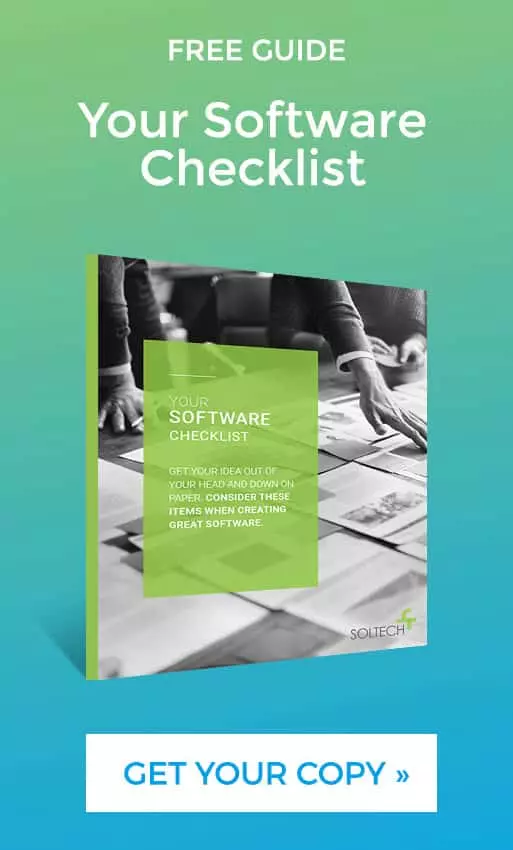
The 8 Most Overlooked Features in Custom Software Products
By Thayer Tate
Despite your best efforts, custom software product releases don’t always generate user excitement and acceptance like you expect. Sometimes, your final product just falls short of user expectations even when you’ve gathered thorough requirements and executed a flawless development effort. Even with the “best-laid plans” for your custom software product, users won’t always be satisfied. Why?

The biggest challenge many of us face in planning a custom software product is getting out of our own heads and into the heads of our end-users. Surprisingly, we often see that a very small group of internal stakeholders drives the overwhelming majority of software requirements and designs—and with limited input or validation from the software’s target user groups. Focusing on a User Persona during the design process can help address this challenge, especially when you also add proper user validation and market research to the process. However, sometimes you can fail to consider certain software features, simply due to a lack of familiarity with software design and best practices. Also, some software features are often considered but don’t make the final cut because their importance is undervalued.
What are some of the most overlooked and under-valued features that are often missing in custom software releases?
1. User Experience Analytics
A certain amount of guesswork about user needs and wants goes into designing any software product. Beta testing during app development provides you with insights into how users use your application, but usually only considers relatively small sample sizes. Whether you do a lot of user research or very little, you should make sure you can capture user experience analytics so that you quickly identify issues and resolve them.

You may immediately think that dropping Google Analytics into your app will fulfill this need, but it usually falls short in tracking User Experience. Instead, consider a tool like Full Story, which offers extremely powerful tools to understand how users are using your application and where the trouble spots are. How many abandon their carts? How many rage-click on dead links? When you know how users react to your app, you make more informed decisions regarding enhancements and changes. You can also quickly smooth out the rough spots and overcome design issues.
2. Application Programming Interfaces (APIs)
People commissioning custom apps often overlook providing APIs in those applications. Very common, but not always applicable, enterprise clients often want Business-to-Business (B2B) models to interface with vendor products using APIs, and not use your application. In B2B models, large data sets are commonly interchanged, and clients don’t want to enter or extract records one by one using an application. We have seen many organizations lose the chance to close big client contracts because they didn’t have an API.
3. Great User Experience
Your application won’t work without a user interface. Despite this core requirement, many organizations still undervalue the importance and effort that goes into building a great user experience. One of the most common mistakes is designing an application for an internal stakeholder’s approval and sign-off instead of building your app for end-user approval.
Users see and navigate your app differently than you will and they will judge your app compared to the other apps and websites they regularly use. You should conduct research early on to understand your user audience and their expectations. For example, the age ranges, genders, and cultures of your user audience are just a few important factors you should know and consider when designing your user experience.
4. Mobile App Experience
Most people will consider a Mobile App when coming up with their software product idea, but they later have to decide whether that’s an initial release requirement or a future phase item. Many companies start custom app development by building web applications—because they’re cheaper and have a wider range of users.
It’s a solid, tried-and-true strategy; however, it’s not always the right approach. For example, younger generations prefer app stores over websites, so the target demographic is just one huge factor that should play into this decision. There is no one right answer and building a Web App and a Mobile App at the same time will add to the expense of your initial product roll-out.

The important point here is to clearly understand your users and consciously decide to pursue a web app and/or a mobile app, based on market research.
5. Automations
Users want convenience. Sometimes, you need to consider how your software will drive efficiency, even if it takes more development effort to do so. Automation creates shortcuts for your power-users and is one of the most beloved features of mature apps that are often overlooked in new product releases. For example, some commonly requested automations include: workflow approvals via email, triggered system notifications, and shortcut keys to cut down on mouse clicks.
6. Admin Functionality
In app development, the user experience gets so much attention that the administrative experience sometimes suffers. When admins go to disable users, moderate comments, and process payments and cancellations, they need an admin experience that works. When you’re designing your application, you should think beyond its customer-facing aspects. Remember to think about the types of support requests you will receive from customers and the tools your internal teams will need to research and resolve issues.
7. Error Logging/Notifications
How will the app notify you when it’s broken? Apps are not self-healing and no system will run on autopilot. If a credit card gets declined, how will you (and the customer) know? When you’re starting small, at 100 transactions a day, you might be able to process errors manually.
This gets harder when you reach thousands or tens of thousands of daily transactions. Additionally, when you get a support call from a client, how are you going to research issues if there are no log files? Error logging, combined with proper Administrative functionality, often gets overlooked and undervalued when planning out early software releases.
8. Search Engine Optimization (SEO)
SEO isn’t an on/off switch or one-time activity. Not everyone seeking custom software understand SEO. If SEO is part of your marketing strategy, it should be a key consideration in the design strategy of your app. SEO helps create search engine traffic.
Many people don’t sufficiently prioritize SEO, believing that “if they build it, the people will find it and come.” In app design, you should have an upfront SEO strategy instead of retrofitting your app for SEO down the road. Additionally, content heavily drives SEO, so it’s hard to have a meaningful SEO strategy without a well-conceived content strategy.
Conclusion
With app development, there are many competing priorities to balance such as user needs, administrative needs, competitive pressures, and the pragmatic realities of budget and time limitations. However, as long as you stay focused on user needs and ensure you don’t forget some of these overlooked features, you have a much greater chance of having a successful roll-out. With a proper user experience analytics strategy, you’ll be able to identify challenges early and address them. Users are generally understanding and supportive so long as they see that you are considering and addressing their feedback and that you have a plan for how you will mature the application after the initial release.
Thayer Tate
Chief Technology Officer Thayer is the Chief Technology Officer at SOLTECH, bringing over 20 years of experience in technology and consulting to his role. Throughout his career, Thayer has focused on successfully implementing and delivering projects of all sizes. He began his journey in the technology industry with renowned consulting firms like PricewaterhouseCoopers and IBM, where he gained valuable insights into handling complex challenges faced by large enterprises and developed detailed implementation methodologies.
Thayer is the Chief Technology Officer at SOLTECH, bringing over 20 years of experience in technology and consulting to his role. Throughout his career, Thayer has focused on successfully implementing and delivering projects of all sizes. He began his journey in the technology industry with renowned consulting firms like PricewaterhouseCoopers and IBM, where he gained valuable insights into handling complex challenges faced by large enterprises and developed detailed implementation methodologies.
Thayer’s expertise expanded as he obtained his Project Management Professional (PMP) certification and joined SOLTECH, an Atlanta-based technology firm specializing in custom software development, Technology Consulting and IT staffing. During his tenure at SOLTECH, Thayer honed his skills by managing the design and development of numerous projects, eventually assuming executive responsibility for leading the technical direction of SOLTECH’s software solutions.
As a thought leader and industry expert, Thayer writes articles on technology strategy and planning, software development, project implementation, and technology integration. Thayer’s aim is to empower readers with practical insights and actionable advice based on his extensive experience.







